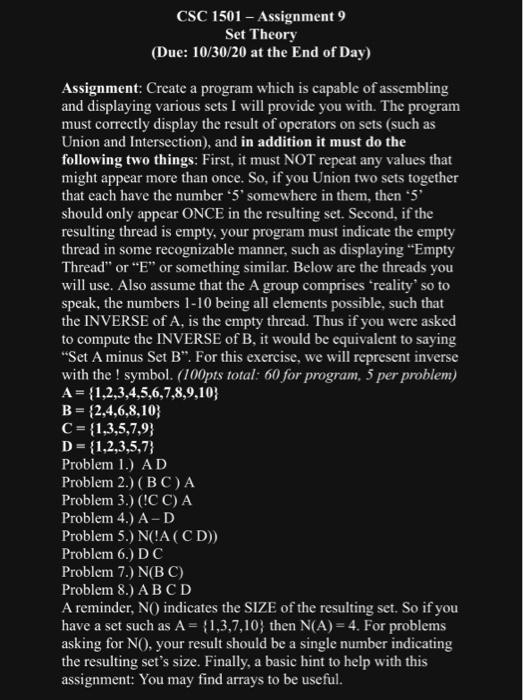CSC 1501 – Assignment 9
Set Theory (Due: 10/30/20 at the End of Day)
Assignment:
Create a program which is capable of assembling and displaying various sets I will provide you with. The program must correctly display the result of operators on sets (such as Union and Intersection), and in addition it must do the following two things:
First, it must NOT repeat any values that might appear more than once. So, if you Union two sets together that each have the number ‘5’ somewhere in them, then ‘5’ should only appear ONCE in the resulting set.
Second, if the resulting set is empty, your program must indicate the empty set in some recognizable manner, such as displaying “Empty Set” or “E” or something similar.
Below are the sets you will use. Also assume that the set A comprises ‘reality’ so to speak, the numbers 1-10 being all elements possible, such that the INVERSE of A is the empty set. Thus if you were asked to compute the INVERSE of B, it would be equivalent to saying “Set A minus Set B”. For this exercise, we will represent inverse with the symbol “!”.
(100 pts total: 60 for program, 5 per problem)
A={1,2,3,4,5,6,7,8,9,10}
B={2,4,6,8,10}
C={1,3,5,7,9}
D={1,2,3,5,7}
Problem 1.) A ∩ D
Problem 2.) (B ∪ C) ∩ A
Problem 3.) !(C ∪ C) ∩ A
Problem 4.) A – D
Problem 5.) |!(A ∪ (∪ C D))|
Problem 6.) D ∪ C
Problem 7.) |!(B ∪ C)|
Problem 8.) |A ∪ B ∪ C ∪ D|
A reminder, |S| indicates the size of the resulting set. So if you have a set such as A={1,3,7,10}, then |A|=4. For problems asking for |S|, your result should be a single number indicating the resulting set’s size.
Finally, a basic hint to help with this assignment: You may find arrays to be useful.
 All Study Co-Pilots are evaluated by Gotit Pro as an expert in their subject area.
All Study Co-Pilots are evaluated by Gotit Pro as an expert in their subject area.

 25% off with code “SUMMER”
25% off with code “SUMMER”

